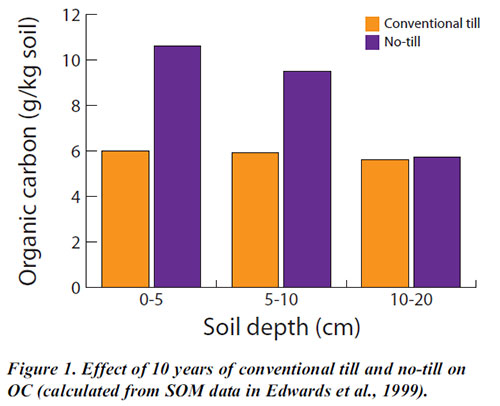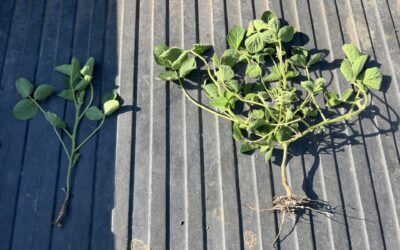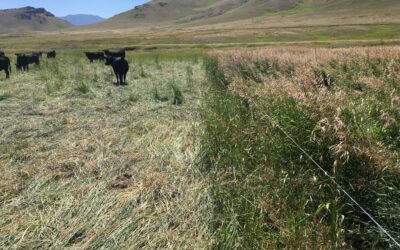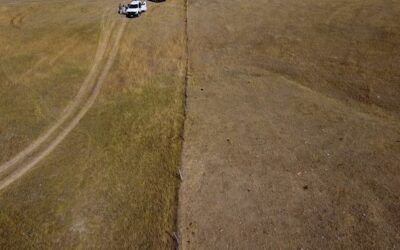Total Organic Carbon
 Total organic carbon (TOC) is the carbon (C) stored in soil organic matter (SOM). Organic carbon (OC) enters the soil through the decomposition of plant and animal residues, root exudates, living and dead microorganisms, and soil biota. SOM is the organic fraction of soil exclusive of nondecomposed plant and animal residues. Nevertheless, most analytical methods do not distinguish between decomposed and non-decomposed residues. SOM is a heterogeneous, dynamic substance that varies in particle size, C content, decomposition rate, and turnover time.
Total organic carbon (TOC) is the carbon (C) stored in soil organic matter (SOM). Organic carbon (OC) enters the soil through the decomposition of plant and animal residues, root exudates, living and dead microorganisms, and soil biota. SOM is the organic fraction of soil exclusive of nondecomposed plant and animal residues. Nevertheless, most analytical methods do not distinguish between decomposed and non-decomposed residues. SOM is a heterogeneous, dynamic substance that varies in particle size, C content, decomposition rate, and turnover time.
Soil organic carbon (SOC) is the main source of energy for soil microorganisms. The ease and speed with which SOC becomes available is related to the SOM fraction in which it resides. In this respect, SOC can be partitioned into fractions based on the size and breakdown rates of the SOM in which it is contained (table 1). The first three fractions are part of the active pool of SOM. Carbon sources in this pool are relatively easy to break down.
SOM contains approximately 58% C; therefore, a factor of 1.72 can be used to convert OC to SOM. There is more inorganic C than TOC in calcareous soils. TOC is expressed as percent C per 100 g of soil.
Relationship to Soil Function
SOC is one of the most important constituents of the soil due to its capacity to affect plant growth as both a source of energy and a trigger for nutrient availability through mineralization. SOC fractions in the active pool, previously described, are the main source of energy and nutrients for soil microorganisms. Humus participates in aggregate stability, and nutrient and water holding capacity.
OC compounds, such as polysaccharides (sugars) bind mineral particles together into microaggregates. Glomalin, a SOM substance that may account for 20% of soil carbon, glues aggregates together and stabilizes soil structure making soil resistant to erosion, but porous enough to allow air, water and plant roots to move through the soil. Organic acids (e.g., oxalic acid), commonly released from decomposing organic residues and manures, prevents phosphorus fixation by clay minerals and improve its plant availability, especially in subtropical and tropical soils. An increase in SOM, and therefore total C, leads to greater biological diversity in the soil, thus increasing biological control of plant diseases and pests. Data also reveals that interaction between dissolved OC released from manure with pesticides may increase or decrease pesticide movement through soil into groundwater.
Problems with Poor Carbon Levels
A direct effect of poor SOC is reduced microbial biomass, activity, and nutrient mineralization due to a shortage of energy sources. In non-calcareous soils, aggregate stability, infiltration, drainage, and airflow are reduced. Scarce SOC results in less diversity in soil biota with a risk of the food chain equilibrium being disrupted, which can cause disturbance in the soil environment (e.g., plant pest and disease increase, accumulation of toxic substances).
Improving Carbon Levels
Compiled data shows that farming practices have resulted in the loss of an estimated 4.4×109 tons of C from soils of the United States, most of which is OC. To compensate for these losses, practices such as no-till may increase SOC (figure 1). Other practices that increase SOC include continuous application of manure and compost, and use of summer and/or winter cover crops. Burning, harvesting, or otherwise removing residues decreases SOC.
This Page Was Created Utilizing Text And Images From These Sources:

West River Soil Health School Registration Open!
In 2024, the South Dakota Soil Health Coalition will host an additional Soil Health School in west of the Missouri River! The 2024 West River Soil Health School with be held June 26-27 near Caputa, SD! This school will focus on issues specific to the land, climate, and ag production systems of wester South Dakota. Class size is limited, so early registration is strongly encouraged!
News & Events
Farmer reaps higher yields by interseeding soybeans
By Stan Wise Alex Frasier has spent a lot of time studying what it takes to grow a successful crop. After studying ag production and precision technology at Lake Area Technical College, he has worked in ag retail and currently works as an agronomist in Aberdeen, SD....
Farm and ranch innovators to share new ideas at Soil Health Conference
By Stan Wise PIERRE, SD — Before Cooper Hibbard came home to manage his family’s ranch, he studied ag business, rangeland resources and Spanish at California Polytechnic State University and then worked on ranches all over the world. That education and experience...
Wintertime is decision time
By Stan Wise PIERRE, SD – It’s often said that the best time to start improving your land was 20 years ago, but the second-best time is right now. That statement might be harder for ranchers to swallow with winter on their doorstep, nothing growing in their pastures,...


